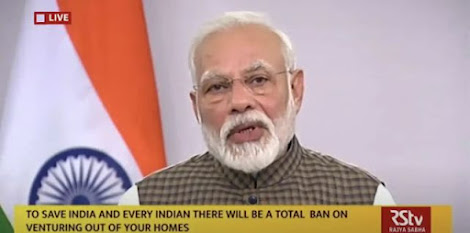Published 27 Mar, 2023
PTI
Welcome to The India Fix by Shoaib Daniyal, a newsletter on Indian politics. To get it in your inbox every week, sign up here (click on “follow”). Have feedback, interesting links or memes? Send them to theindiafix@scroll.in.
Three years ago, Indians tuned into their television sets (and laptops and mobile phones) to watch Prime Minister Narendra Modi announce a complete lockdown of the entire Indian Union.
It was an unprecedented moment in global history. In one fell swoop, Modi had frozen all economic activity and movement for a sixth of humanity. “There will be a complete ban on people from stepping outside their houses from 12 midnight today,” Modi declared, putting in place a curfew for 1.3 billion people.
Lockdowns first arose in prominence in China, as Beijing grappled with controlling the Covid-19 virus that had arisen first in the country. However, as Scroll had first reported, the intensity of what India was attempting to do was unprecedented: Modi’s lockdown was the harshest in the world. Moreover, it was imposed in knee-jerk fashion. A country with more people than the continents of South and North America combined was frozen overnight.
A screengrab from Modi's March 24, 2020 address ordering that all Indians are barred from leaving their houses as part of the lockdown.
Pushed into tragedy
The result, obviously, was catastrophic. The first tragedy occurred as millions of migrant workers tried to flee the cities they were working in. Most of these migrant workers were poor, had few savings and lived hand-to-mouth on their daily earnings. With the lockdown shutting down all economic activity, their wages suddenly stopped. Staying in the cities would have meant starving to death. Naturally, they preferred to flee, often making superhuman journeys back home.
As many commentators remarked at the time, it was the greatest human migration India was seeing since Partition. Nearly 9,000 people were killed just along railway tracks, mostly workers walking back home. The true number of workers killed while trying to walk or cycle hundreds, sometimes thousands of kilometres back home, will never be known.
As catastrophic as the migrant worker exodus was, it was just the visible tip of the misery caused due to India’s draconian lockdown. For example, the shutting down of public transport services meant that the vast majority of Indians were suddenly unable to access healthcare. Patients were blocked from kidney and dialysis and chemotherapy treatments. HIV and tuberculosis patients were unable to buy medicines.
Something as basic as pregnant women accessing maternal healthcare became a gargantuan task. There were over 5,80,000 fewer institutional deliveries in April than in January 2020, a sign that women were being forced to undertake unsafe deliveries at home.
While the exact numbers of deaths will never be known, estimates show that the sudden cessation of nearly all healthcare services as a result of India’s lockdown could have led to lakhs of deaths.
Migrant workers climb out of a refrigerated truck after they were stopped by police as they try to return to their villages to escape the lockdown. Danish Siddiqui/Reuters
All of this, of course, occurred against a level of economic devastation not seen since the British Raj. The lockdown led to the worst economic contraction since Independence. As economists Swati Dhingra and Maitreesh Ghatak explained, the brunt of much of this was borne by India’s poorest citizens. A paper by economists Jean Drèze and Anmol Somanchi found that “the lockdown and the economic recession that followed led to a severe nutrition crisis”.
The Union government, of course, blames this contraction on an act of God. However, while the pandemic struck the entire world, no other country experienced the level of economic devastation that India did during 2020.
Knee-jerk
For a policy so draconian, even three years later, Indians have never been told how it was decided on. A BBC report, for example, found that there was “no evidence of key experts or government departments being consulted prior to the lockdown being implemented”. Since it was seemingly decided as a knee-jerk reaction, the Union government simply did not consider the impact of its lockdown on vulnerable constituencies such as migrant workers, cancer patients or pregnant women.
Even more troublingly, the legal powers of New Delhi to impose such a harsh measure are, even three years later, still unclear. As Scroll had reported at the time, since both law and order and health lie with the states, how the Union had imposed a national lockdown was itself was unclear. Rather than working with the states, this use of blunt force by the Union government was counterproductive given that, at the end of the day, it was the states that had to implement the lockdown and manage the virus on the ground.
Empty utensils belonging to a resident are seen as he waits to receive free food at an industrial area during the lockdown in New Delhi. Credit: Danish Siddiqui/Reuters
Checks and balances?
Another federal country, the United States, never imposed a national, curfew-style lockdown. Although the country had bitter debates about the policies needed to fight the virus, arguably its federal structure saved the country from a catastrophe like India’s 2020 lockdown.
To the credit of Indian democracy, singed by the human and economic suffering during the 2020 lockdown, the Modi government refused to impose any such harsh restrictions during the rest of the pandemic. Ironically, India’s massive second Covid-19 wave in 2021 saw almost no lockdown restrictions. However, as Scroll reported in 2021, even in the face of the massive flood of deaths, what poor Indians feared most was not Covid – but another 2020-style lockdown.
That a tragedy like the 2020 lockdown could happen is a grim reminder of how few checks and balances stop India’s all powerful Union government and how little stands between overwhelming state power and an Indian citizen’s rights.

.jpg)


.jpg)